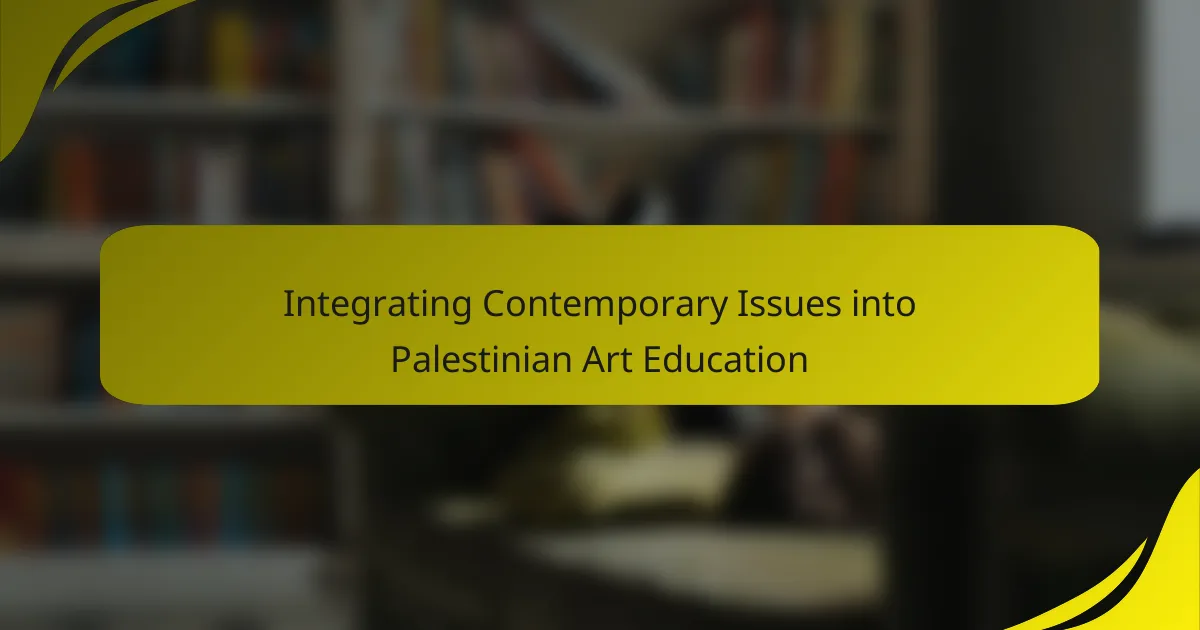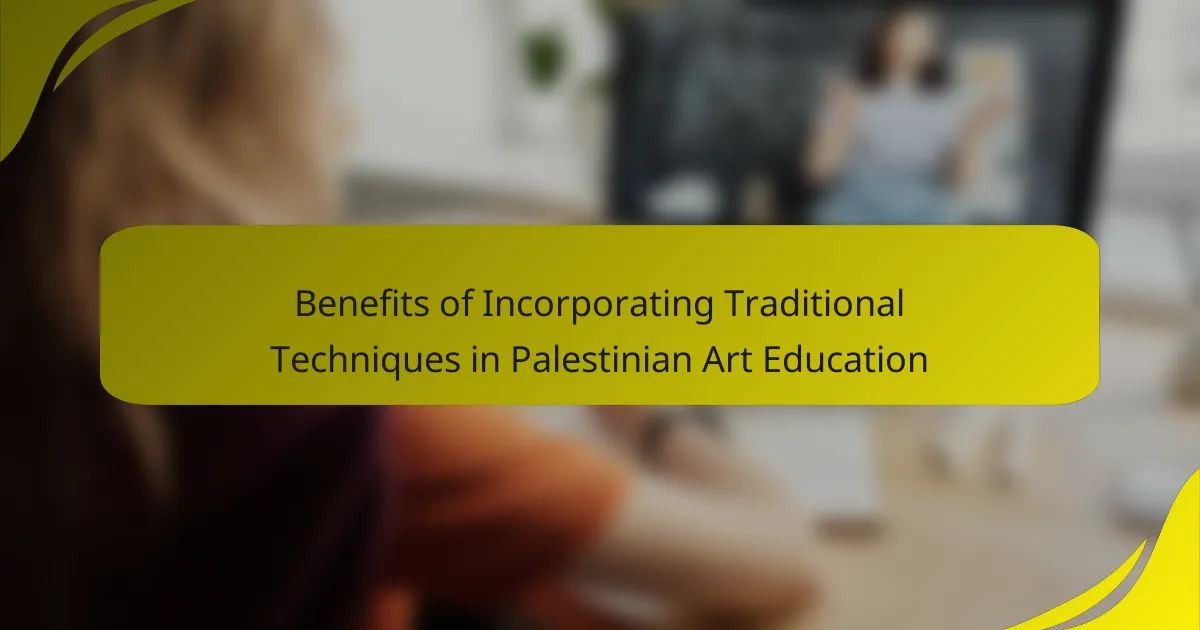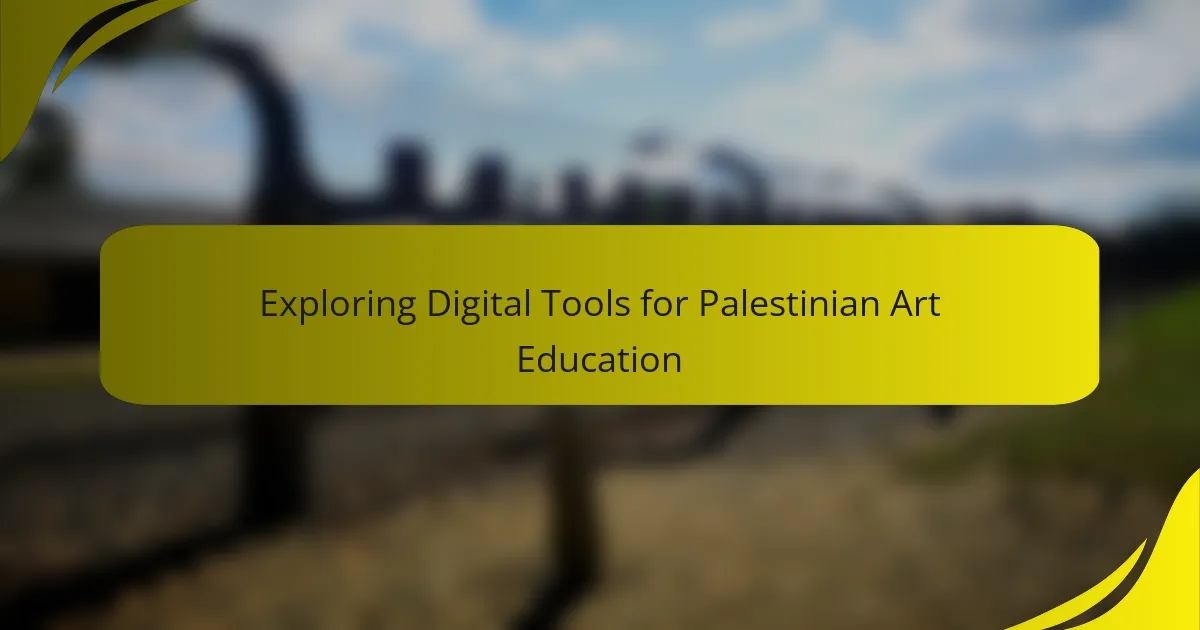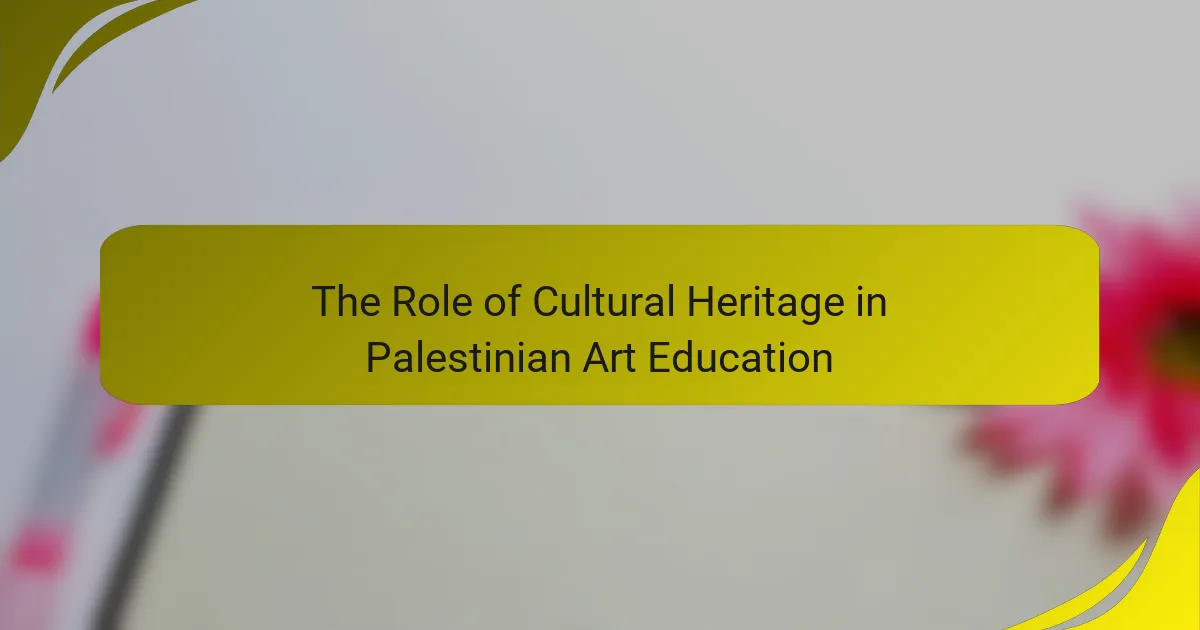Community engagement plays a crucial role in enhancing Palestinian art education by fostering collaboration among artists, educators, and local communities. This collaboration leads to the creation of culturally relevant curricula and increases access to artistic expression through community workshops. Engaged communities provide essential resources and support for art programs, which in turn cultivates a sense of identity and belonging among participants. Furthermore, community involvement facilitates exhibitions that showcase local talent, inspiring future generations of artists while ensuring that art education reflects the realities of Palestinian life. Research indicates that such engagement not only improves educational outcomes but also promotes resilience, creativity, and social cohesion within diverse community members.
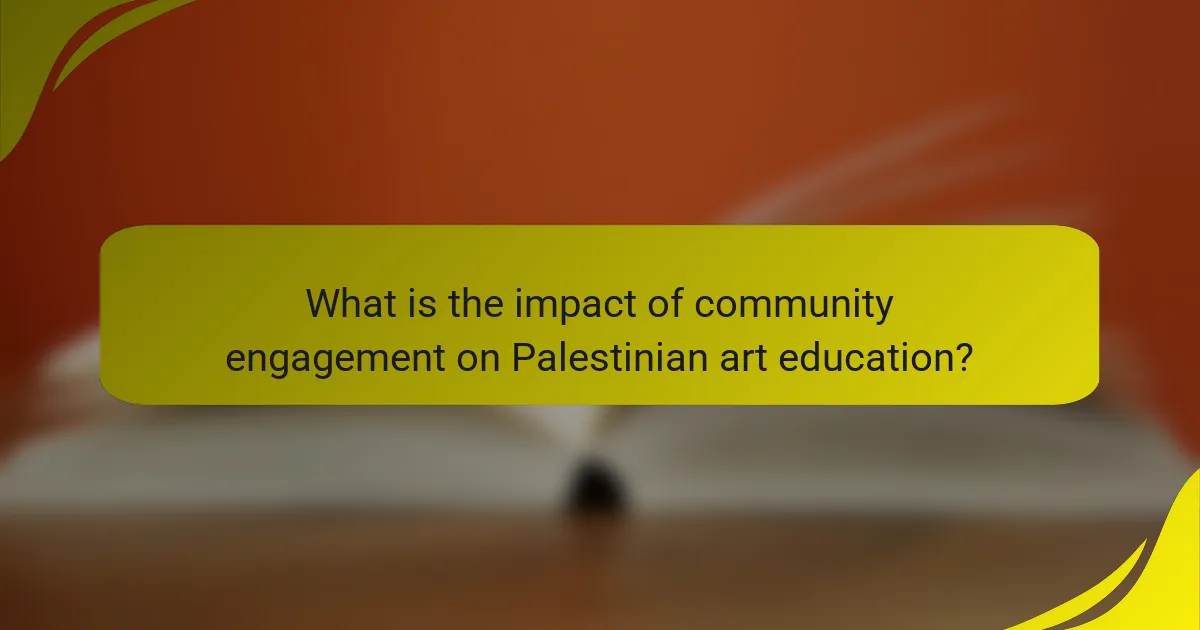
What is the impact of community engagement on Palestinian art education?
Community engagement significantly enhances Palestinian art education. It fosters collaboration between artists, educators, and local communities. This collaboration leads to the development of culturally relevant curricula. Engaged communities can provide resources and support for art programs.
Research shows that art education in Palestine benefits from communal participation. For instance, community workshops increase access to artistic expression. They also cultivate a sense of identity and belonging among participants. Engagement helps to bridge gaps in educational resources. It promotes resilience and creativity in challenging environments.
Moreover, community involvement can lead to exhibitions that showcase local talent. This visibility can inspire future generations of artists. Engaging the community ensures that art education reflects the realities of Palestinian life. Such an approach enriches the educational experience for students.
How does community engagement influence the development of art education in Palestine?
Community engagement significantly influences the development of art education in Palestine. Engaged communities contribute resources, support, and local knowledge essential for art programs. This involvement fosters a sense of ownership among participants. It also enhances the relevance of art education to local cultural contexts. For instance, community-led initiatives often address unique social issues through art. Studies show that such programs improve student motivation and creativity. They also create opportunities for collaboration between artists and educators. Ultimately, community engagement cultivates a vibrant artistic landscape that reflects Palestinian identity and heritage.
What are the key elements of community engagement in this context?
The key elements of community engagement in the context of Palestinian art education include collaboration, participation, and empowerment. Collaboration involves partnerships between artists, educators, and community members to co-create educational programs. Participation is crucial as it encourages community members to actively engage in the art-making process. Empowerment allows individuals to express their cultural identity and develop skills through art. These elements foster a sense of belonging and ownership in the educational experience. Evidence shows that community-driven art initiatives enhance cultural awareness and promote social cohesion among participants.
How do these elements contribute to art education initiatives?
Community engagement elements enhance art education initiatives by fostering collaboration and inclusivity. They encourage diverse perspectives, enriching the learning experience. Engaged communities provide resources and support for art programs. This involvement can lead to increased participation and investment in art education. Research indicates that community-driven initiatives improve student outcomes and engagement. For example, a study by the National Endowment for the Arts highlights the positive correlation between community involvement and artistic development in educational settings. Such elements create a supportive environment that nurtures creativity and critical thinking in students.
Why is community engagement crucial for Palestinian artists and educators?
Community engagement is crucial for Palestinian artists and educators because it fosters cultural expression and resilience. Engaging with the community allows artists to reflect local experiences and narratives. It creates a supportive environment for educational initiatives. Collaborative projects enhance artistic skills and knowledge sharing. Community involvement also strengthens social bonds and collective identity. According to a study by the Institute for Palestine Studies, community-driven art projects have significantly increased participation in cultural activities. This engagement empowers artists and educators to address social issues effectively. Ultimately, it cultivates a vibrant cultural landscape that promotes healing and unity.
What challenges do Palestinian artists face without community support?
Palestinian artists face significant challenges without community support. They experience limited access to resources such as funding and materials. This lack of support hampers their ability to create and showcase their work. Additionally, they often struggle with isolation and lack of networking opportunities. Without a supportive community, artists may find it difficult to gain visibility. This can lead to decreased motivation and a sense of disconnection from their cultural identity. The absence of community engagement also limits collaborative projects that could enrich their artistic expression. Overall, the challenges faced by Palestinian artists are deeply intertwined with the lack of community backing.
How does community engagement help overcome these challenges?
Community engagement helps overcome challenges in Palestinian art education by fostering collaboration and resource sharing. Engaged communities create networks that facilitate access to materials and facilities. This collective effort often leads to the establishment of art programs tailored to local needs. Additionally, community involvement enhances motivation among students and educators alike. When community members participate, they provide valuable feedback and support. This collaboration can lead to increased funding opportunities from local and international organizations. Research shows that community-driven initiatives improve educational outcomes and cultural preservation. For instance, programs that involve local artists often result in richer artistic expressions and stronger cultural identity.
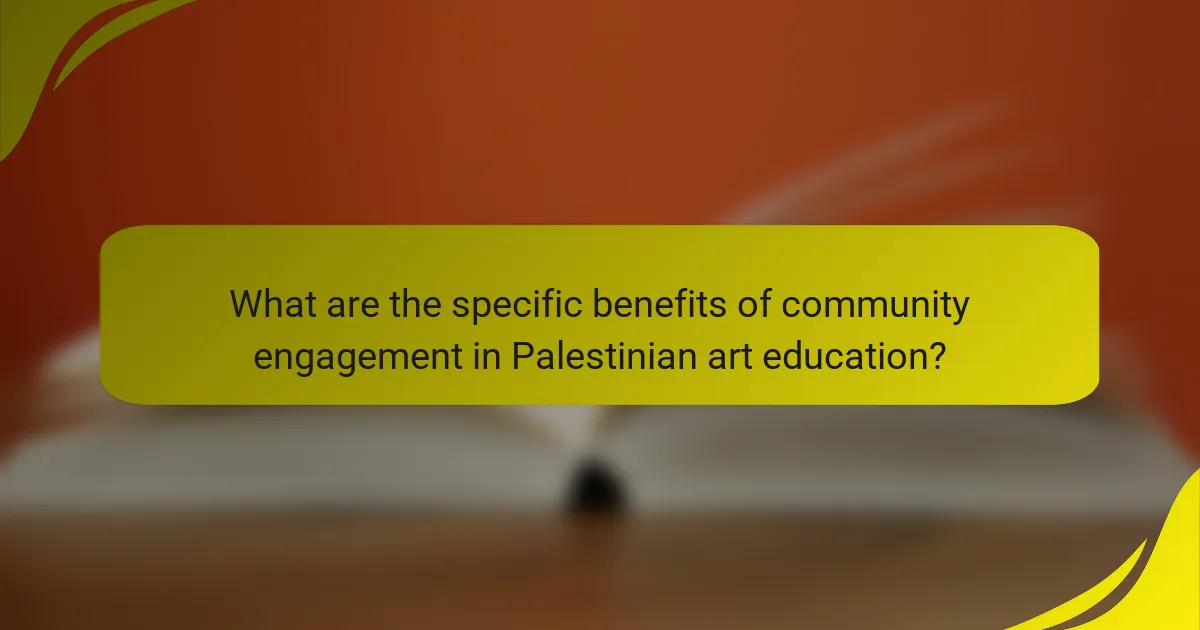
What are the specific benefits of community engagement in Palestinian art education?
Community engagement in Palestinian art education fosters creativity and personal expression. It enhances students’ understanding of their cultural heritage. This engagement also builds social cohesion among diverse community members. Collaborative projects allow for shared learning experiences. Additionally, community support can provide resources for art programs. Engaged communities often lead to increased participation in art initiatives. Studies show that such involvement can improve educational outcomes. For example, the “Art Education in Palestine” report highlights the positive impact on student motivation and achievement.
How does community engagement enhance artistic skills among students?
Community engagement enhances artistic skills among students by providing real-world experiences and collaborative opportunities. Engaging with the community allows students to apply their artistic knowledge in practical settings. This interaction fosters creativity and innovation as students encounter diverse perspectives.
Students also receive feedback from community members, which can refine their skills. Collaborative projects with local artists expose students to different techniques and styles. Research indicates that students involved in community art projects show improved confidence and motivation. For instance, a study by the National Endowment for the Arts highlighted that community-based art initiatives significantly boost students’ artistic expression and skills.
What types of workshops or programs are most effective?
Interactive workshops and community-based programs are most effective in art education. These formats encourage active participation and collaboration among participants. Research shows that hands-on activities enhance learning retention. Additionally, community engagement fosters a sense of belonging and cultural identity. Programs that integrate local art traditions resonate more with participants. A study by the National Endowment for the Arts found that community-driven initiatives significantly improve artistic skills. Workshops that include feedback sessions also promote growth and creativity. Therefore, programs that prioritize interaction and community involvement yield the best results in art education.
How do mentorship opportunities arise from community involvement?
Mentorship opportunities arise from community involvement through networking and shared experiences. When individuals participate in community activities, they often meet others with similar interests. These connections can lead to the establishment of mentor-mentee relationships. Community events provide a platform for exchanging knowledge and skills. Participants can identify potential mentors among experienced community members. Engaging in collaborative projects fosters deeper relationships. These relationships can naturally evolve into mentorship as individuals seek guidance and support. Research indicates that mentorship significantly enhances personal and professional development. This is particularly relevant in fields like art education, where community ties can strengthen learning opportunities.
In what ways does community engagement foster cultural preservation in art education?
Community engagement fosters cultural preservation in art education by actively involving local communities in the learning process. This participation allows for the sharing of traditional techniques and narratives. Engaged communities can contribute their unique cultural stories, enhancing the curriculum. Collaboration with local artists provides students with authentic perspectives on their heritage. Workshops and events organized by community members promote intergenerational knowledge transfer. Research shows that when students connect with their cultural roots, they develop a stronger sense of identity. This connection reinforces the importance of preserving cultural practices through art. Ultimately, community engagement creates a supportive environment for sustaining cultural traditions in education.
What role do local traditions play in art education initiatives?
Local traditions play a significant role in art education initiatives. They provide a cultural context that informs artistic expression. Incorporating local traditions fosters a sense of identity among students. It encourages the preservation of cultural heritage through artistic practices. Art education initiatives that embrace local traditions often engage community members as instructors. This collaboration enhances the relevance of the curriculum. For example, traditional crafts or storytelling can be integrated into lessons. Such approaches have been shown to improve student engagement and retention. By linking art education to local traditions, initiatives can also promote community cohesion. This connection to cultural roots enriches the learning experience for students.
How can community projects help in preserving Palestinian heritage through art?
Community projects can help preserve Palestinian heritage through art by fostering cultural expression and education. These initiatives often involve local artists and community members collaborating on artistic endeavors. They create spaces for sharing traditional stories, techniques, and art forms. For example, mural projects can depict historical events and cultural symbols significant to Palestinian identity. Workshops and classes can teach younger generations about traditional crafts, ensuring skills are passed down. Research shows that community engagement in art enhances cultural pride and awareness. Engaging in these projects also strengthens community bonds, creating a collective commitment to heritage preservation.
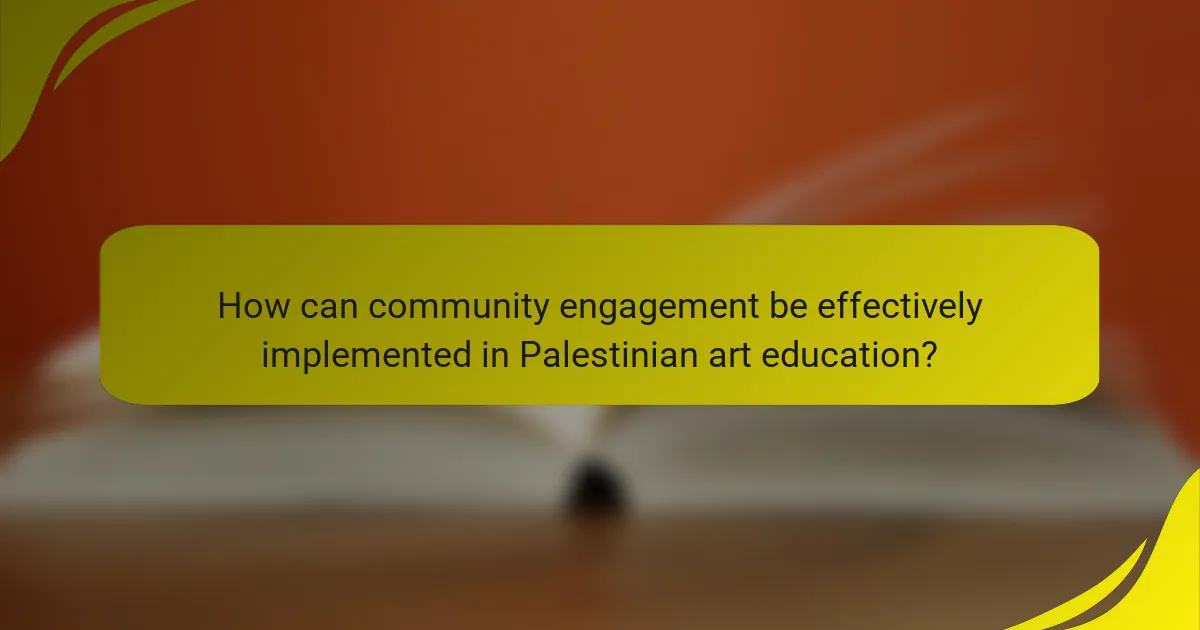
How can community engagement be effectively implemented in Palestinian art education?
Community engagement can be effectively implemented in Palestinian art education through collaborative projects. These projects should involve local artists, educators, and community members. Workshops and exhibitions can be organized to showcase local talent. This approach fosters a sense of ownership among participants. It also encourages the sharing of diverse cultural narratives. Research indicates that community involvement enhances learning outcomes. A study by the Arab Education Forum highlights the positive impact of community-based initiatives on student engagement. By integrating community voices, art education becomes more relevant and meaningful.
What strategies can be employed to increase community participation?
To increase community participation, organizations can implement targeted outreach programs. These programs should focus on identifying and addressing community needs. Engaging local leaders can help build trust and encourage participation. Hosting workshops and events can create opportunities for direct involvement. Utilizing social media platforms can enhance communication and raise awareness. Providing incentives for participation can motivate individuals to get involved. Collaborating with schools and local institutions can expand reach and resources. Regular feedback from the community can help tailor strategies effectively. Research shows that inclusive practices significantly boost community engagement in educational initiatives.
What role do social media and technology play in fostering engagement?
Social media and technology enhance engagement by providing platforms for interaction and communication. They allow individuals to connect across geographical boundaries. These platforms facilitate the sharing of ideas and artistic expressions. For example, artists can showcase their work to a global audience. Technology also enables real-time feedback and collaboration among community members. Studies show that 72% of teens use social media, indicating its prevalence in daily life. This high usage rate fosters a sense of community and belonging. Additionally, social media campaigns can mobilize support for art education initiatives. Overall, social media and technology are crucial tools for fostering engagement in various communities.
How can partnerships with local organizations enhance community involvement?
Partnerships with local organizations enhance community involvement by fostering collaboration and resource sharing. They create platforms for collective action, amplifying community voices. This engagement leads to increased participation in local events and initiatives. Statistics show that communities with strong local partnerships report higher volunteer rates. For example, a study by the National Council of Nonprofits found that organizations collaborating with local entities saw a 30% increase in community engagement. Additionally, these partnerships can provide access to funding and expertise, further enriching community projects. Local organizations often understand community needs better, ensuring relevant programming. This alignment increases trust and encourages more residents to participate actively.
What best practices should be followed for successful community engagement in art education?
Successful community engagement in art education requires inclusive and collaborative practices. First, establish partnerships with local organizations to broaden outreach. This can enhance resource sharing and community involvement. Second, create accessible programs that cater to diverse audiences. Accessibility increases participation from various community segments. Third, involve community members in the planning process. Their input ensures that programs meet local needs and interests. Fourth, provide opportunities for hands-on experiences. Engaging activities foster deeper connections to art. Fifth, promote ongoing communication with the community. Regular updates and feedback loops strengthen relationships. Lastly, evaluate the impact of engagement efforts. Assessment helps refine programs for better effectiveness. These best practices are supported by research indicating that community involvement significantly enhances educational outcomes in art education.
How can feedback from the community shape art education programs?
Feedback from the community can significantly shape art education programs. Community input helps identify local artistic needs and preferences. This ensures that programs are relevant and culturally appropriate. Engaging with community members fosters collaboration and inclusivity. Research indicates that programs tailored to community feedback improve participation rates. For instance, a study by the National Endowment for the Arts found that community-oriented programs increased enrollment by 30%. Additionally, feedback can lead to the introduction of diverse art forms reflective of the community’s heritage. This adaptability enhances the educational experience for students. Overall, community feedback is essential for creating effective and meaningful art education programs.
What are the common pitfalls to avoid when implementing community engagement initiatives?
Common pitfalls to avoid when implementing community engagement initiatives include lack of clear objectives. Without defined goals, initiatives may lose focus and direction. Another pitfall is insufficient community involvement in the planning process. Engaging stakeholders early ensures their needs and perspectives are considered. Failure to communicate effectively can also hinder engagement. Clear and transparent communication fosters trust and participation. Additionally, neglecting to evaluate and adapt initiatives can lead to stagnation. Regular assessment helps identify areas for improvement. Lastly, overlooking cultural sensitivities may alienate community members. Understanding local contexts is crucial for successful engagement.
What practical steps can individuals take to support community engagement in Palestinian art education?
Individuals can support community engagement in Palestinian art education by actively participating in local art initiatives. They can volunteer at art workshops and community centers that focus on Palestinian heritage. Organizing art exhibitions showcasing Palestinian artists fosters visibility and appreciation. Individuals can also donate supplies to art programs in schools and community organizations. Collaborating with local artists to conduct workshops encourages skill-sharing and mentorship. Promoting online campaigns that highlight Palestinian art can raise awareness and attract funding. Establishing partnerships with educational institutions can enhance program reach and resources. Supporting local art markets helps sustain artists and enrich the community’s cultural landscape.
The main entity of this article is community engagement in Palestinian art education. The article explores how community involvement enhances art education by fostering collaboration, cultural relevance, and resource sharing among artists, educators, and local communities. It highlights the benefits of community-driven initiatives, such as improved student motivation, skills development, and cultural preservation. Key elements discussed include the importance of participation, empowerment, and mentorship opportunities, as well as the challenges faced by artists without community support. The article emphasizes best practices for effective engagement and the role of local traditions in enriching the educational experience.
